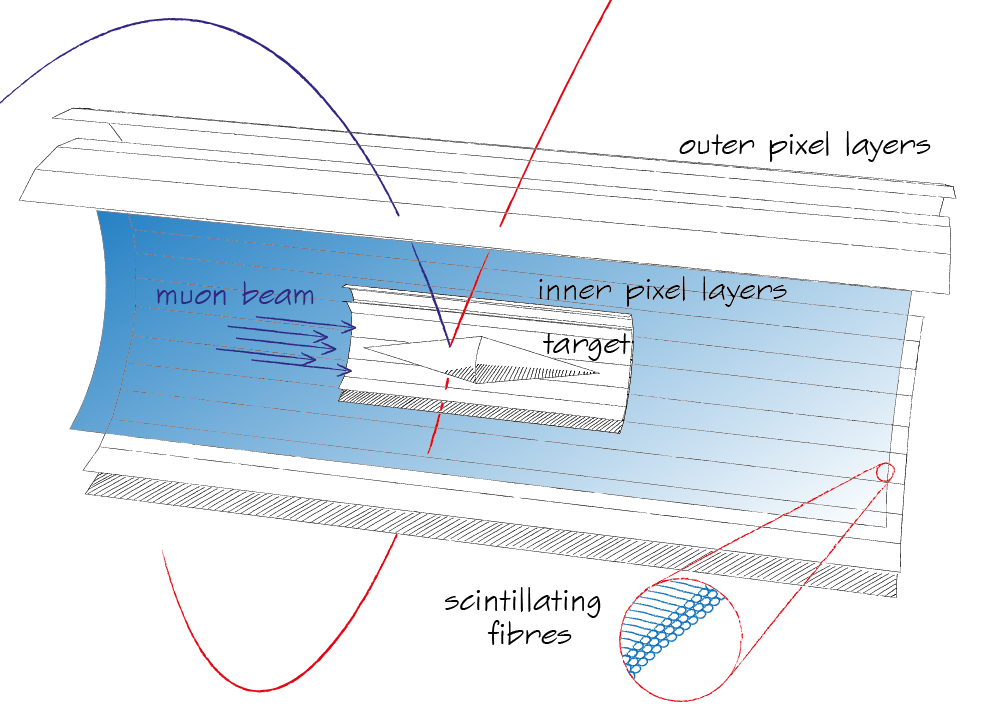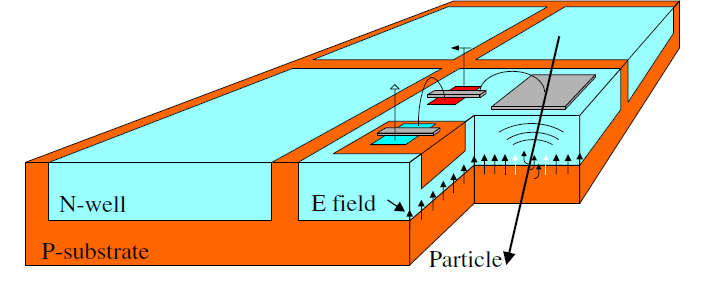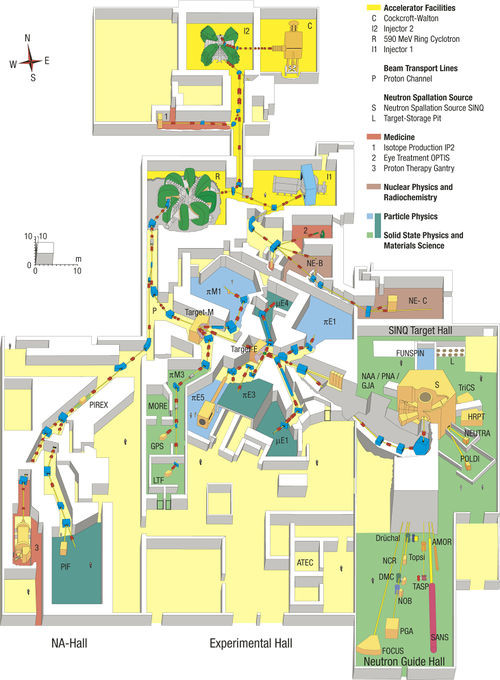The Mu3e Experiment
Motivation
In the standard model of particle physics there are three generations of leptons. In each generation there is a charged and a neutral lepton (neutrino). The lightest and best known charged leptons are the electrons, the more massive charged leptons are muons and taus. In the standard model the transition between the first two generations happens through the weak decay $\mu^+ \rightarrow e^+ \overline{\nu}_{\mu} \nu_e$. The standard model process $\mu^+ \rightarrow e^+e^-e^+$ via a neutrino loop is suppressed to unobservable levels $O(10^{50})$ and does not play a practical role.
Any observation of the decay $\mu^+ \rightarrow e^+e^-e^+$ with the Mu3e experiment would point to physical processes so far not described in the standard model, mediated by the exchange of very heavy particles. These heavy particles could have masses of $O(10^3)$ TeV and would not be visible in direct measurements at the Large Hadron Collider, but are expected in many theoretical models such as super-symmetry, models with extra Higgs bosons or extra dimensions.
The Mu3e Experiment
The Mu3e experiment will observe more than $> 10^{16}$ (10 million billion) muon decays in order to probe the existence of new physics beyond the standard model. This enormous number of muons will be reached by utilizing the worlds most intense muon beam, which produces $> 10^9$ muons/s decaying in the Mu3e detector. In order to filter out the few decays $\mu^+ \rightarrow e^+e^-e^+$ they must be excellently discriminated from possible background.
The dominant background contribution comes from accidental coincidences of tracks from $\mu^+ \rightarrow e^+ \overline{\nu}_{\mu} \nu_e$ decays as well as from the radiative decay with internal conversion $\mu^+ \rightarrow e^+e^-e^+ \overline{\nu}_{\mu} \nu_e$. The suppression of accidental background is reached through excellent timing and vertex (decay point) resolution. The background from $\mu^+ \rightarrow e^+e^-e^+ \overline{\nu}_{\mu} \nu_e$ is suppressed by measuring the missing energy carried away by the two neutrinos. This is best achieved by precise determination of momentum of each electron in a magnetic spectrometer.
Challenges
The Mu3e detector has to meet the following requirements:
- High rate capability ($> 10^9$ muon/s)
- Good vertex resolution (< 200 $\mu\textrm{m}$)
- Good time resolution (< 100 ps)
- Excellent momentum resolution (< 0.5 MeV/c)
- The required excellent momentum resolution for 10-53 MeV/c electrons leads to the additional requirement of extremely low material budget in the active detector volume as otherwise the electrons would be strongly scattered.
Tracking Detectors
These requirements are met by a silicon pixel detector in a ~1 T magnetic field around a double-cone target, plus two timing detector systems. The silicon pixel detector is composed of a cylindrical double layer close to the target (vertex tracker), a central cylindrical double layer at ~8 cm radius (central outer tracker) and cylindrical double layers both in the forward and the backward extension of the central outer tracker. The extensions precisely measure the position and thus momentum of the recurling electrons and are referred to as the recurl stations. The overall length of the silicon tracker stations is about 1 m.
The sensors of the silicon tracker are High Voltage Active Pixel Sensors (HV-MAPS), which implies that the sensor pixels and the detector electronics are integrated into the same chip. The HV-MAPS have a size of 2 x 2 cm$^2$. The size of one pixel is 80 x 80 $\mu\textrm{m}^2$. As the sensors can be thinned to around 50 $\mu\mathrm{m}$ without significant loss of signal efficiency and do not require an extra readout chip inside the active tracking volume, the radiation length can be kept very low ($1.1\cdot 10^{-3} X_0$ per layer).
Timing Detectors
The two timing systems are important to separate the $>10^9$ muon decay events from one another and thus lower the chance of accidental background. The first timing detector is a fiber hodoscope around the target at ~7 cm radius, just inside the central outer tracker. The required timing resolution is ~1 ns. The central position allows to determine the time of all electrons reaching the central outer tracker (down to 12 MeV/c momentum). The fiber tracker consists of three layers of 250 $\mu\textrm{m}$ thick fibers, read out at both ends. The second timing system is located inside the recurl stations and consists of scintillating tiles. The tiles allow for a very accurate time measurement with about 70 ps resolution. The vicinity of either timing system to a silicon pixel tracking layer simplifies the association of tracks and timing information.
Magnet
The Mu3e magnet is a superconducting solenoid magnet with ~1 T field. All detector components are inside the warm bore of magnet. To minimize the interaction of the neighboring experiments and the solenoid field a magnet return flux yoke of cylindrical symmetry is required.
Readout
The readout of the Mu3e experiment is un-triggered. A 125 MHz system clock is used to give timestamps to the data from the silicon tracking system. Zero-suppressed data from the silicon tracker sensors are send to FPGAs (programmable devices) and then via optical data transmission to the counting room. The data from the timing systems are taken with a time-to-digital converter chip (MuTrig). In the counting room the data is received by a computing farm of around a dozen PCs equipped with graphical processing units (GPUs). With the help of the enormous computing power of the commercial GPUs the track reconstruction and momentum determination is done in real time. With the help of the online filtering the events stored on disk will be kept at a moderate bandwidth of < 100 MB/s. The events that could be signal $\mu^+ \rightarrow e^+ e^- e^+$ events are kept for more precise off-line analysis.
Muon Beam
The Paul Scherrer Institute Switzerland has a very high intensity proton beam of 2.2 mA at 590 MeV/s. In phase I of the Mu3e experiment we will use the up to few $10^8$/s surface muons from target E. In order to constrain the $\mu^+ \rightarrow e^+ e^- e^+$ branching fraction to $<10^{16}$ or to make measurements of signal events, a new muon beam line (HIMB) will be established. Several $10^9$ muons/s are expected at HIMB, allowing Mu3e to reach the ultimate sensitivity goal but also creating new challenges for the detector.
Schedule
The time line for the Mu3e experiment is currently the following:
- 2014-2022 Detector development
- 2023/24 Detector construction, installation and commissioning at PSI
- 2025+ Data taking at up to a few $10^8$ muons/s (Phase I)
- 2027+ Construction of a new muon beam line at PSI
- 2028++ Data taking at up to $2\cdot 10^9$ muon/s (Phase II)
-- D. Wiedner/ N. Berger - 6 Feb 2019, last updated 5 May 2023





